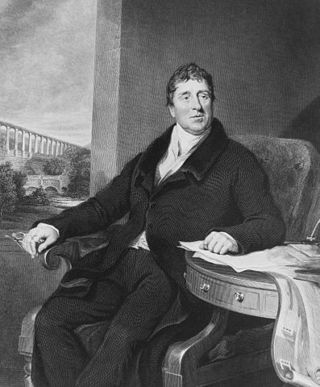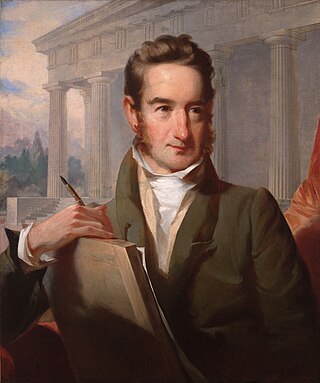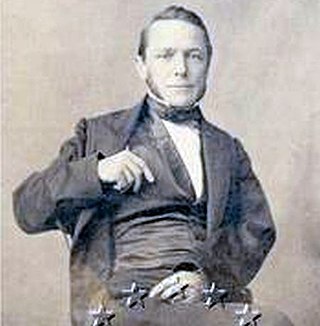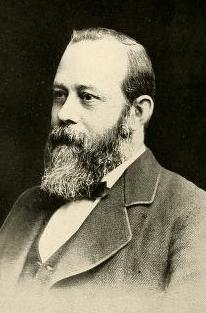External links
- Norman White, his ancestors and his descendants: more bio detail on Strickland
- Creativity in Cast Iron: Strickland Kneass’s Chestnut Street Bridge
Strickland Landis Kneass (July 29, 1821, in Philadelphia - January 14, 1884, in Philadelphia) was a United States civil engineer, municipal surveyor, and railroad president.
Kneass's father, William Kneass, was for many years engraver of the U.S. Mint. His older brother was civil engineer and architect Samuel Honeyman Kneass. The younger Kneass attended Rensselaer Institute, where he graduated in 1839 at the age of 18 [1] with highest honors. [2]
After graduation, Kneass "held various surveying and engineering jobs, including the post of Principal Assistant Engineer for the Pennsylvania Railroad. He helped conduct the preliminary surveys, and supervised construction of a section of the line, including several bridges and the Tussy Mountain Tunnel," wrote Adam Levine, a historical consultant for the Philadelphia Water Department. [2]
From 1855 until 1872, Kneass was chief engineer and surveyor of the consolidated city of Philadelphia. Among other things, he "re-designed Philadelphia's drainage system, designed new bridges to cross the Schuylkill River, and set up the extension of the City's streetcar system," according to the Athenaeum of Philadelphia. [3] His most notable work is Philadelphia's 1866 cast-iron Chestnut Street Bridge.
In 1872, he became assistant to the president of the Pennsylvania Railroad. In 1880, Kneass became president of the Pennsylvania and Delaware and other railroads. [1] [4]

Thomas Telford was a Scottish civil engineer. After establishing himself as an engineer of road and canal projects in Shropshire, he designed numerous infrastructure projects in his native Scotland, as well as harbours and tunnels. Such was his reputation as a prolific designer of highways and related bridges, he was dubbed the Colossus of Roads, and, reflecting his command of all types of civil engineering in the early 19th century, he was elected as the first president of the Institution of Civil Engineers, a post he held for 14 years until his death.

Frank Heyling Furness was an American architect of the Victorian era. He designed more than 600 buildings, most in the Philadelphia area, and is remembered for his diverse, muscular, often inordinately scaled buildings, and for his influence on the Chicago-based architect Louis Sullivan. Furness also received a Medal of Honor for bravery during the Civil War.

Thomas Ustick Walter was an American architect of German descent, the dean of American architecture between the 1820 death of Benjamin Latrobe and the emergence of H.H. Richardson in the 1870s. He was the fourth Architect of the Capitol and responsible for adding the north (Senate) and south (House) wings and the central dome that is predominantly the current appearance of the U.S. Capitol building. Walter was one of the founders and second president of the American Institute of Architects. In 1839, he was elected as a member to the American Philosophical Society.

William Strickland was a noted architect and civil engineer in Philadelphia, Pennsylvania, and Nashville, Tennessee. A student of Benjamin Latrobe and mentor to Thomas Ustick Walter, Strickland helped establish the Greek Revival movement in the United States. A pioneering engineer, he wrote a seminal book on railroad construction, helped build several early American railroads, and designed the first ocean breakwater in the Western Hemisphere. He was elected as a member of the American Philosophical Society in 1820.

The Philadelphia, Wilmington and Baltimore Railroad (PW&B) was an American railroad that operated independently from 1836 to 1881. Headquartered in Philadelphia, it was greatly enlarged in 1838 by the merger of four state-chartered railroads in three Mid-Atlantic states to create a single line between Philadelphia and Baltimore.

William Kneass was the second Chief Engraver of the United States Mint from 1824 until his death in 1840. Kneass is credited with designing the "Classic Head" motif, which appeared on numerous denominations of American currency, including the gold quarter eagle ($2.50) and half eagle ($5.00) gold pieces from 1834 to 1839. He also modified John Reich's "Capped Bust" design for use on the half dime through half-dollar from 1829 to 1837.
Benjamin Henry Latrobe II was an American civil engineer, best known for his railway bridges, and a railway executive.

John Cresson Trautwine was an American civil engineer, architect, and engineering writer.

Philadelphia's Baltimore & Ohio Railroad station – also known as the B & O station or Chestnut Street station – was the main passenger station for the Baltimore & Ohio Railroad in Philadelphia, Pennsylvania. Designed by architect Frank Furness in 1886, it stood at 24th Street and the Chestnut Street Bridge from 1888 to 1963.

The Chestnut Street Bridge is a bridge across the Schuylkill River that carries Chestnut Street in Philadelphia, Pennsylvania. The original 1861 bridge was "a bridge whose scale and use of cast iron made it singular in the United States and throughout the world". The 1957 bridge, now one way, helps connect West Philadelphia with the rest of the city.

Silas Seymour was an American civil engineer and politician from New York.
Elnathan Sweet was an American civil engineer and politician from New York. He was New York State Engineer and Surveyor from 1884 to 1887. He is credited with constructing the first cantilever arch bridge.

Campbell W. Adams was an American civil engineer, surveyor and politician from New York. He was New York State Engineer and Surveyor from 1894 to 1898.

Wilson Brothers & Company was a prominent Victorian-era architecture and engineering firm established in Philadelphia, Pennsylvania. The company was regarded for its structural expertise.
Joseph S. Gitt was a self-taught civil engineer and politician from Pennsylvania. After an unsuccessful career as a newspaper publisher, Gitt went back into railroading, estimating that in his career, he had conducted 31 different railroad surveys for a total distance of over 300 miles in his career Gitt either surveyed or engineered most of the railroads constructed in Frederick and Carroll county, Maryland and Adams county, Pennsylvania in the 1855-1885 period with the exception of the civil war.
Charles Lombaert (1790-1875) was an American contracting engineer. Most notably, he was a superintendent for the Philadelphia, Wilmington and Baltimore Railroad, which in 1838 completed the first rail link between the three cities.
Samuel Honeyman Kneass (1806–1858) was an American civil engineer and architect.
Herman Joseph Lombaert (1816–1885) was an American civil engineer who helped complete the first railroad between Philadelphia, Pennsylvania, and Baltimore, Maryland, and eventually became a vice-president of the Pennsylvania Railroad (PRR).

Joachim Gotsche Giæver was a Norwegian born, American civil engineer who designed major structures in the United States.

John Henry Dye was an American civil engineer and surveyor based in Philadelphia, Pennsylvania. His 1869 city map, made with printer Henry J. Toudy, has been described as "a major milestone in the urban mapping of Philadelphia."